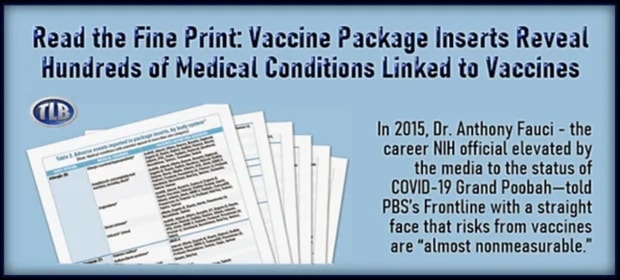
Read the Fine Print: Vaccine Package Inserts Reveal Hundreds of Medical Conditions Linked to Vaccines
In March 2015, Dr. Anthony Fauci—the career National Institutes of Health official elevated by the media to the status of COVID-19 Grand Poobah—told PBS’s Frontline with a straight face that risks from vaccines are “almost nonmeasurable.” Fauci then proceeded to downplay every potential vaccine risk proposed by the interviewer, stating that each had “no basis in reality.” Having served at the helm of the National Institute of Allergy and Infectious Diseases (NIAID) since 1984, Fauci surely was aware then, and is aware now, that the National Vaccine Injury Compensation Program established in the late 1980s has paid out billions of dollars to the vaccine-injured: $4.3 billion as of April 1, 2020. Did Fauci feel that he could get away with making such dismissive statements because he knew about the Harvard study from 2010 showing that fewer than 1% of vaccine adverse events get reported—and what isn’t reported can’t be measured?
All package inserts (made available online by both the FDA and vaccine companies) contain a section on Postmarketing Experience (Section 6.2) that lists adverse events “spontaneously reported in the US and other countries” after the vaccine’s licensure.
Vaccines belong to the class of pharmaceutical products called biologics, products that allergy experts widely recognize for their “potential to cause allergic hypersensitivity reactions,” among other adverse effects. Is Dr. Fauci—director of an institution focused on allergies and immunology—unaware that the package inserts of at least 22 vaccines list allergic hypersensitivity reactions as an adverse event, and that the inserts of at least 31 vaccines list post-vaccine anaphylactic reactions?
The fact is that vaccine package inserts are one of the few available sources of detailed information that consumers can turn to when they want to sidestep official stonewalling and learn about the more than 200 adverse events reported for vaccines given to children and adolescents. All package inserts (made available online by both the FDA and vaccine companies) contain a section on Postmarketing Experience (Section 6.2) that lists adverse events “spontaneously reported in the US and other countries” after the vaccine’s licensure. Manufacturers include adverse events in the list on the basis of severity, frequency of reporting and strength of evidence for a causal relationship to the vaccine. They also include adverse events that may not have been detected during the vaccine’s clinical trials.
… vaccines—promoted for the prevention of 13 illnesses—have yielded postmarketing reports of at least 217 adverse medical outcomes, including death.
Shining a light on the fine print
To facilitate parents’ use of the information buried in small print in the package inserts, Children’s Health Defense has conducted a comprehensive review of the adverse events reported in Section 6.2 for all vaccines currently included in the U.S. childhood and adolescent vaccine schedule. The review includes 38 vaccine brands produced by 8 different manufacturers to protect against diphtheria, Haemophilus influenzae type b, hepatitis A, hepatitis B, human papillomavirus, influenza, meningococcal infection, pertussis, pneumococcal infection, polio, rotavirus, tetanus and varicella (Table 1). According to the information compiled from the inserts, these vaccines—promoted for the prevention of 13 illnesses—have yielded postmarketing reports of at least 217 adverse medical outcomes, including death (Table 2).
There are several things to note about the information presented in Table 2. First, while we used the verbatim insert terminology for each disorder and also largely stuck to the disease groupings in the package inserts, we added two categories—allergic and autoimmune disorders—that the inserts surprisingly omit. (The package inserts lump allergic reactions in with “immune system disorders.”) Second, there are a number of disorders that fit in more than one category; in those instances, we have included them (with an asterisk*) in both places (while counting them once). Third, the table only includes those adverse events that manufacturers decided to report in the inserts—but other adverse events are not only possible but likely, due to the widespread problem of underreporting. Notably, none of the package inserts include any mention of prevalent, childhood-onset neurodevelopmental disorders like tics or autism that published, peer-reviewed studies have linked to vaccines.
…the Pentacel vaccine (which contains a Hib component) can produce “invasive Hib disease”; the RotaTeq vaccine (for rotavirus) is associated with “transmission of vaccine virus strains to the unvaccinated”; and some influenza vaccines trigger influenza.
Themes
As readers peruse Table 2, they may notice the following themes:
-
Every single vaccine on the childhood/adolescent vaccine schedule is responsible for at least one adverse event. For example, as already noted, roughly four out of five vaccines (82%) are associated with reports of anaphylactic reactions. The incidence of anaphylaxis has been climbing in the U.S. for several decades. Medications are the top known triggers of anaphylaxis, while another 39% of anaphylaxis cases are idiopathic, meaning that the cause is “unknown.”
-
Vaccines can cause the very illnesses—or adverse consequences of those illnesses—that they are supposed to prevent. In the era of measles hype and hysteria, it is particularly important to point out that both MMR vaccines—MMR-II and ProQuad—are failing to prevent “atypical measles” (both vaccines), “measles” (ProQuad), “measles-like rash” (MMR-II) and “skin infections” (ProQuad). Likewise, the package inserts report “varicella” and “varicella-like rash” in the aftermath of vaccination with Varivax and ProQuad (which combines varicella with MMR). Equally concerning, the MMR-II and ProQuad vaccines—which have shifted mumps from a noneventful childhood illness to a fertility-endangering condition afflicting adolescents and adults—have produced reports of serious testicular problems (epididymitis and orchitis). Table 2 also shows that the Pentacel vaccine (which contains a Hib component) can produce “invasive Hib disease”; the RotaTeq vaccine (for rotavirus) is associated with “transmission of vaccine virus strains to the unvaccinated”; and some influenza vaccines trigger influenza.
-
Vaccines can also cause other serious infections. For example, the risky MMR-II, ProQuad and Varivax trio is linked to “pneumonia” and “pulmonary congestion,” the Infanrix and Pediarix vaccines are associated with “respiratory tract infections” and seven different vaccines are associated with various forms of meningitis. Ironically (or perhaps not), pneumonia and meningitis are the targets of the pneumococcal and meningococcal vaccines.
-
Vaccine adverse events affect numerous body systems, including the immune and nervous systems. Although the longest list of adverse impacts—41—is for effects on the nervous system, the wide-ranging list also shows effects on the blood, connective tissue, ears, eyes, gastrointestinal system, heart, liver, lymph nodes, musculoskeletal system, respiratory system, skin and more.
Dr. Fauci himself might want to take note of the fact that companies like Johnson & Johnson, one of those rushing to develop a coronavirus vaccine, have been censured by the Department of Justice for drug marketing fraud that exposed children and the elderly to serious side effects, including death.
Measurable and often unsafe
All pharmaceutical products come with potential side effects, and vaccines are no exception. For Dr. Fauci to describe the adverse events associated with vaccines as “almost nonmeasurable”—when they are not only described in package inserts but tracked in postmarketing surveillance systems such as the U.S. Vaccine Adverse Event Reporting System (VAERS), the European EudraVigilance system and the World Health Organization’s VigiBase system—is not only disingenuous but unethical. Given that Dr. Fauci’s wife is a senior NIH bioethicist, the NIAID director’s ethically murky eagerness to de-emphasize the prevalence and significance of vaccine adverse events is surprising.
As the COVID-19 situation has brought Fauci into the limelight as “explainer-in-chief” of the epidemic—and proponent-in-chief of patentable vaccines that will use untested technologies while leapfrogging over ordinary vaccine development protocols—we would do well to query Fauci’s five-year-old throwaway remarks about vaccine safety. Dr. Fauci himself might want to take note of the fact that companies like Johnson & Johnson, one of those rushing to develop a coronavirus vaccine, have been censured by the Department of Justice for drug marketing fraud that exposed children and the elderly to “serious side effects, including death.”
Much has been made of Fauci’s, NIAID’s and the NIH’s cozy entanglements with Bill Gates, the Bill & Melinda Gates Foundation and the Gates-Foundation-created Coalition for Epidemic Preparedness Innovations (CEPI), particularly in light of the massive Gates Foundation and CEPI funding being directed toward coronavirus vaccines that the NIH is also supporting. Gates recently called for digital “certificates” showing who has received an eventual coronavirus vaccine and also made veiled statements that “you don’t want people moving around the world” unless they have received a vaccine. In that context, Fauci’s additional remarks in the 2015 Frontline interview take on somewhat ominous overtones. The good doctor stated that while “there’s never a situation where someone is going to tie you down and vaccinate you . . . you don’t want the respect for autonomy of people to get in the way of a public health mandate.”
Download the PDF
Table 1. Vaccine package inserts reviewed
| Type of Vaccine | Brand Name | Manufacturer |
| Vaccines containing diphtheria, tetanus and pertussis components | Adacel (Tdap) Boostrix (Tdap) Daptacel (DTaP) Diphtheria and Tetanus Toxoids Adsorbed (DT) Infanrix (DTaP) Kinrix (DTaP-IPV) Pediarix (DTaP-HepB-IPV) Pentacel (DTaP-IPV/Hib) Quadracel (DTaP-IPV) Tdvax (Td) Tenivac (Td) |
Sanofi Pasteur GlaxoSmithKline (GSK) Sanofi Sanofi GSK GSK GSK Sanofi Sanofi MassBiologics Sanofi |
| Haemophilus influenzae type b vaccines | ActHIB (Hib) Hiberix (Hib) PedvaxHIB (Hib) |
Sanofi GSK Merck |
| Hepatitis vaccines | Engerix-B (HepB) Havrix (HepA) Recombivax HB (HepB) Twinrix (HepA/HepB) Vaqta (HepA) |
GSK GSK Merck GSK Merck |
| Human papillomavirus (HPV) vaccines | Gardasil Gardasil 9 |
Merck Merck |
| Influenza vaccines | Afluria Quadrivalent Fluarix Flublok Quadrivalent (age 18 and older) Flucelvax Flulaval Quadrivalent FluMist Fluzone Quadrivalent |
Sequirus GSK Protein Sciences Corporation Sequirus GSK AstraZeneca Sanofi |
| Meningococcal vaccines | Bexero Trumenba |
GSK Pfizer |
| Measles-mumps-rubella (MMR) and MMR+varicella vaccines | MMR-II (MMR) Proquad (MMRV) |
Merck Merck |
| Pneumococcal vaccines | Prevnar-13 Pneumovax-23 |
Pfizer Merck |
| Inactivated polio vaccine (IPV) | IPOL (IPV) | Sanofi |
| Rotavirus vaccines | Rotarix RotaTeq |
GSK Merck |
| Varicella vaccine | Varivax | Merck |
Table 2. Adverse events reported in package inserts, by body system*
[Note: Medical conditions with asterisks appear in more than one category.]
*There are several things to note about the information presented in Table 2. First, while we used the verbatim insert terminology for each disorder and also largely stuck to the disease groupings in the package inserts, we added two categories—allergic and autoimmune disorders—that the inserts surprisingly omit. (The package inserts lump allergic reactions in with “immune system disorders.”) Second, there are a number of disorders that fit in more than one category; in those instances, we have included them (with an asterisk*) in both places (while counting them once). Third, the table only includes those adverse events that manufacturers decided to report in the inserts—but other adverse events are not only possible but likely, due to the widespread problem of underreporting. Notably, none of the package inserts include any mention of prevalent, childhood-onset neurodevelopmental disorders like tics or autism that published, peer-reviewed studies have linked to vaccines.
View/Download PDF
••••
The above article Read the Fine Print: Vaccine Package Inserts Reveal Hundreds of Medical Conditions Linked to Vaccines originated on the Children’s Health Defense site and is re-published here by ‘contribution’ with attribution to the Childrens Health Defense team.
••••
TLB Editors Note: This is World Mercury Project on steroids! TLB highly recommends you click on the image below, visit this great website, and do whatever you can to help see this vital forum succeed … for the sake of our children !!!
Sign up for free news and updates from Robert F. Kennedy, Jr. and the Children’s Health Defense. CHD is planning many strategies, including legal, in an effort to defend the health of our children and obtain justice for those already injured. Your support is essential to CHD’s successful mission.
••••

••••
The Liberty Beacon Project is now expanding at a near exponential rate, and for this we are grateful and excited! But we must also be practical. For 7 years we have not asked for any donations, and have built this project with our own funds as we grew. We are now experiencing ever increasing growing pains due to the large number of websites and projects we represent. So we have just installed donation buttons on our websites and ask that you consider this when you visit them. Nothing is too small. We thank you for all your support and your considerations … (TLB)
••••
Comment Policy: As a privately owned web site, we reserve the right to remove comments that contain spam, advertising, vulgarity, threats of violence, racism, or personal/abusive attacks on other users. This also applies to trolling, the use of more than one alias, or just intentional mischief. Enforcement of this policy is at the discretion of this websites administrators. Repeat offenders may be blocked or permanently banned without prior warning.
••••
Disclaimer: TLB websites contain copyrighted material the use of which has not always been specifically authorized by the copyright owner. We are making such material available to our readers under the provisions of “fair use” in an effort to advance a better understanding of political, health, economic and social issues. The material on this site is distributed without profit to those who have expressed a prior interest in receiving it for research and educational purposes. If you wish to use copyrighted material for purposes other than “fair use” you must request permission from the copyright owner.
••••
Disclaimer: The information and opinions shared are for informational purposes only including, but not limited to, text, graphics, images and other material are not intended as medical advice or instruction. Nothing mentioned is intended to be a substitute for professional medical advice, diagnosis or treatment.





